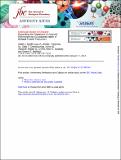Expanding the Repertoire of Amyloid Polymorphs by Co-polymerization of Related Protein Precursors
Author(s)
Sarell, Claire J.; Woods, Lucy A.; Su, Yongchao; Debelouchina, Galia Tzvetanova; Ashcroft, Alison E; Griffin, Robert Guy; Stockley, Peter G.; Radford, Sheena E.; ... Show more Show less
DownloadGriffin_Expanding the repertoire.pdf (3.506Mb)
PUBLISHER_POLICY
Publisher Policy
Article is made available in accordance with the publisher's policy and may be subject to US copyright law. Please refer to the publisher's site for terms of use.
Terms of use
Metadata
Show full item recordAbstract
Amyloid fibrils can be generated from proteins with diverse sequences and folds. Although amyloid fibrils assembled in vitro commonly involve a single protein precursor, fibrils formed in vivo can contain more than one protein sequence. How fibril structure and stability differ in fibrils composed of single proteins (homopolymeric fibrils) from those generated by co-polymerization of more than one protein sequence (heteropolymeric fibrils) is poorly understood. Here we compare the structure and stability of homo and heteropolymeric fibrils formed from human β2-microglobulin and its truncated variant ΔN6. We use an array of approaches (limited proteolysis, magic angle spinning NMR, Fourier transform infrared spectroscopy, and fluorescence) combined with measurements of thermodynamic stability to characterize the different fibril types. The results reveal fibrils with different structural properties, different side-chain packing, and strikingly different stabilities. These findings demonstrate how co-polymerization of related precursor sequences can expand the repertoire of structural and thermodynamic polymorphism in amyloid fibrils to an extent that is greater than that obtained by polymerization of a single precursor alone.
Date issued
2013-01Department
Massachusetts Institute of Technology. Department of Chemistry; Francis Bitter Magnet Laboratory (Massachusetts Institute of Technology)Journal
Journal of Biological Chemistry
Publisher
American Society for Biochemistry and Molecular Biology (ASBMB)
Citation
Sarell, C. J., L. A. Woods, Y. Su, G. T. Debelouchina, A. E. Ashcroft, R. G. Griffin, P. G. Stockley, and S. E. Radford. “Expanding the Repertoire of Amyloid Polymorphs by Co-polymerization of Related Protein Precursors.” Journal of Biological Chemistry 288, no. 10 (March 8, 2013): 7327-7337. .
Version: Final published version
ISSN
0021-9258
1083-351X